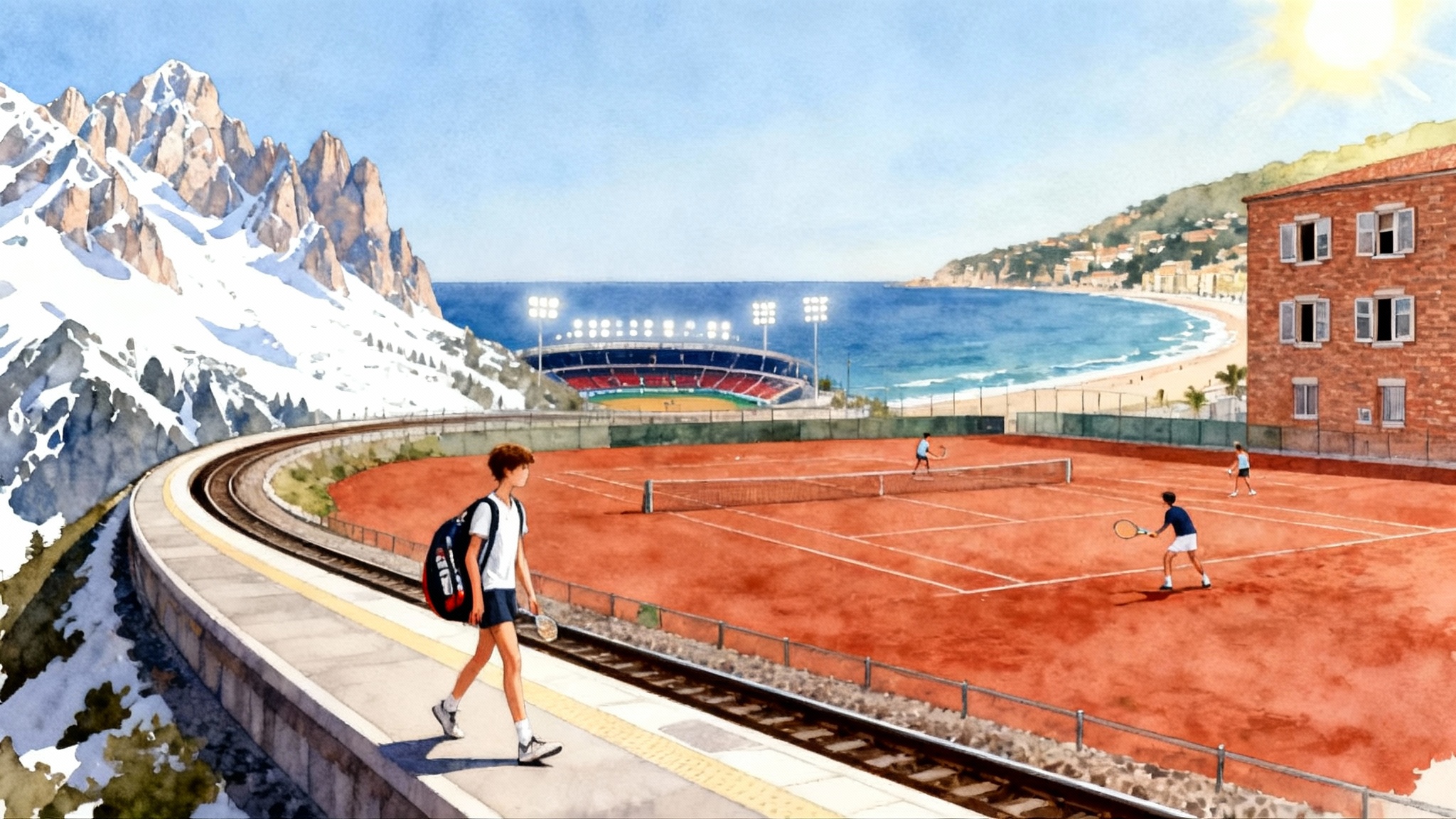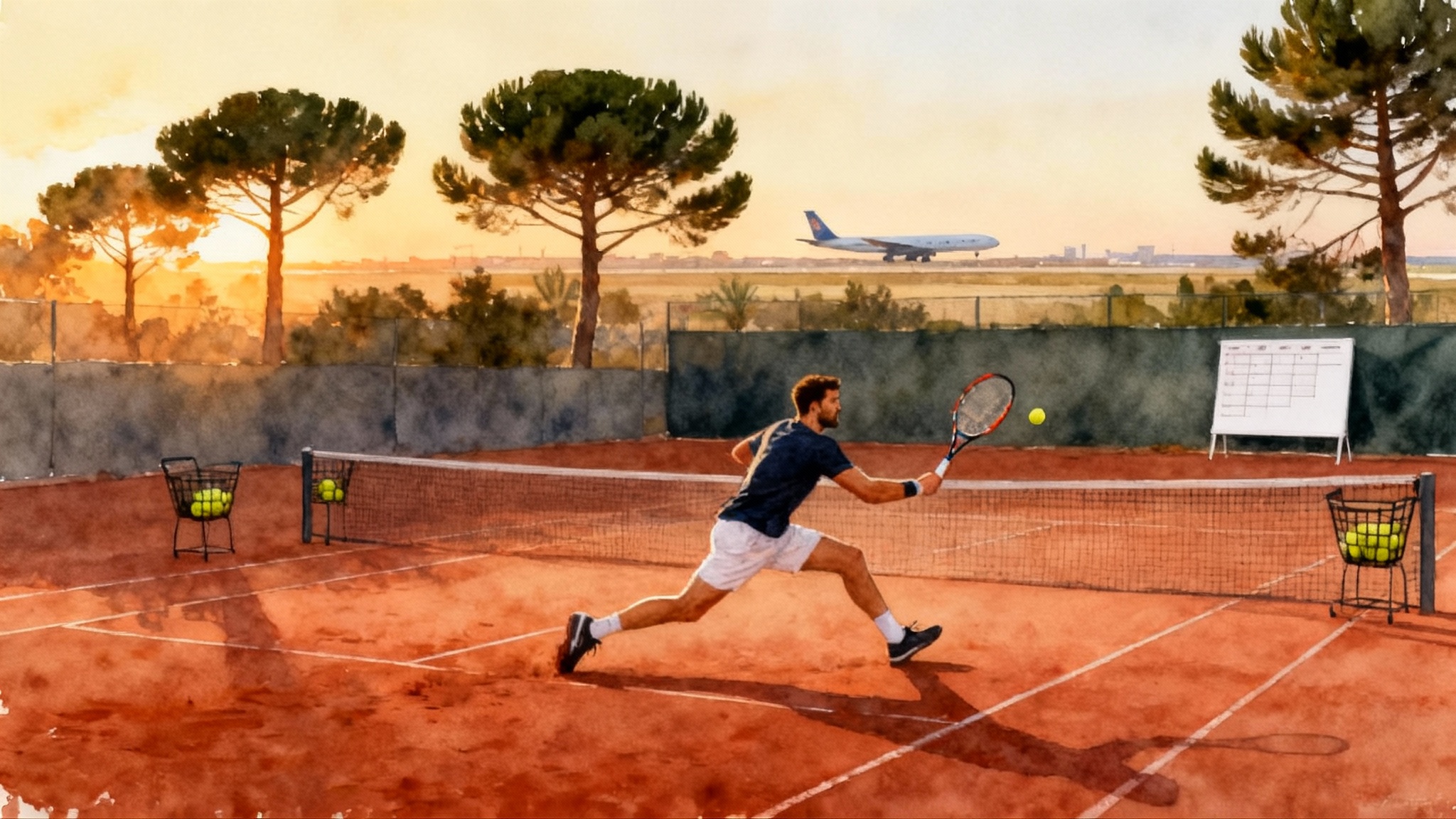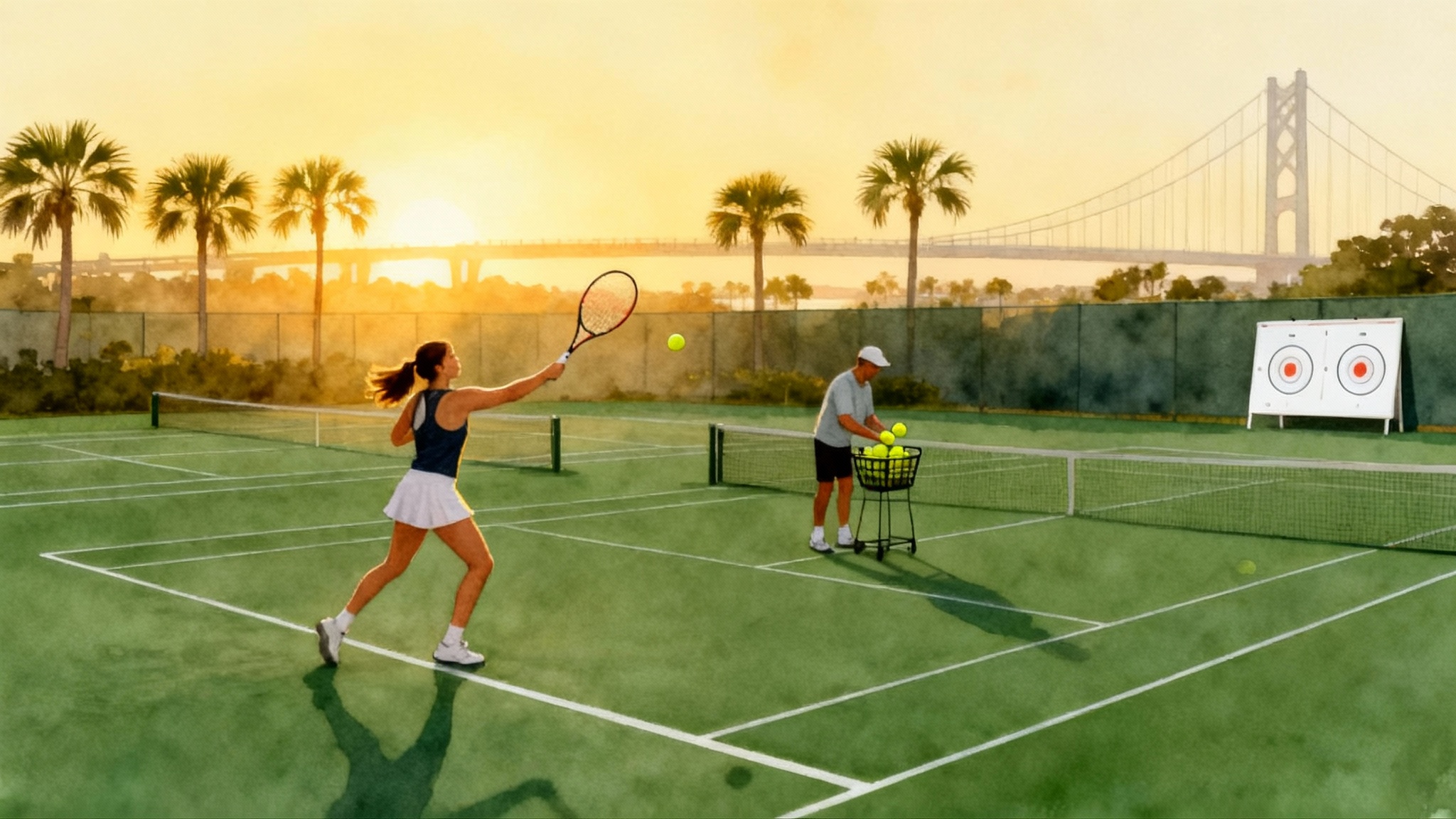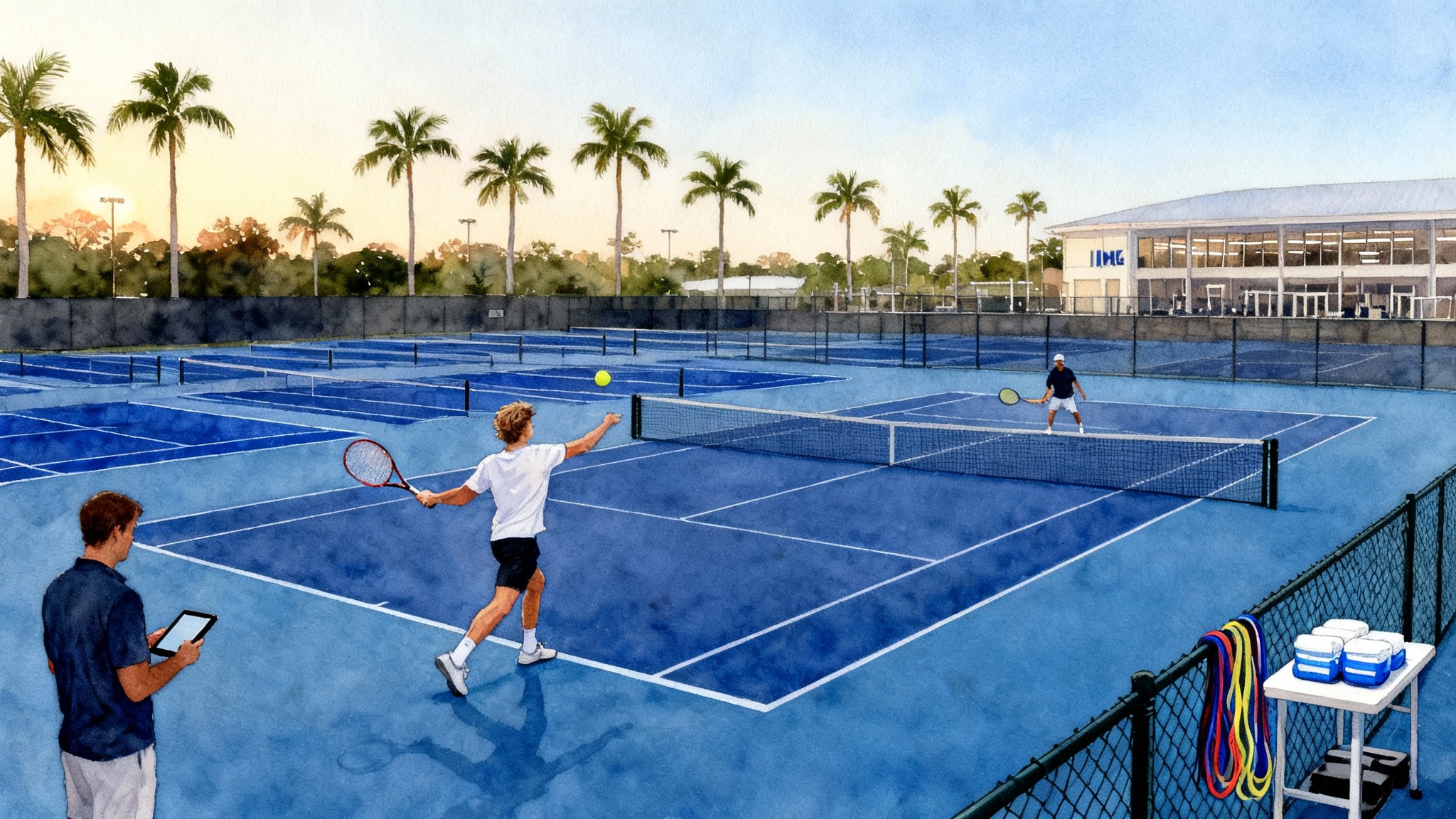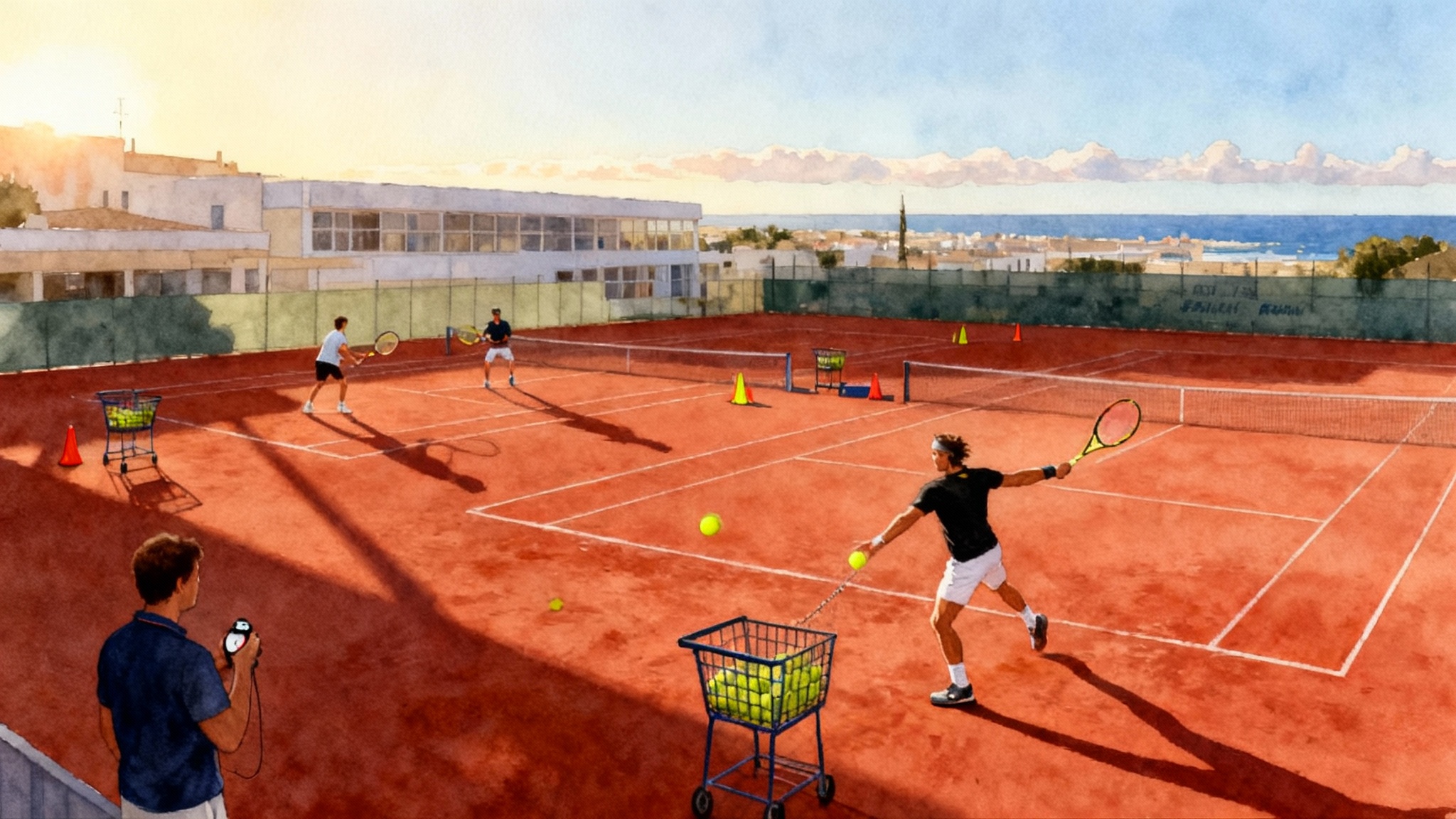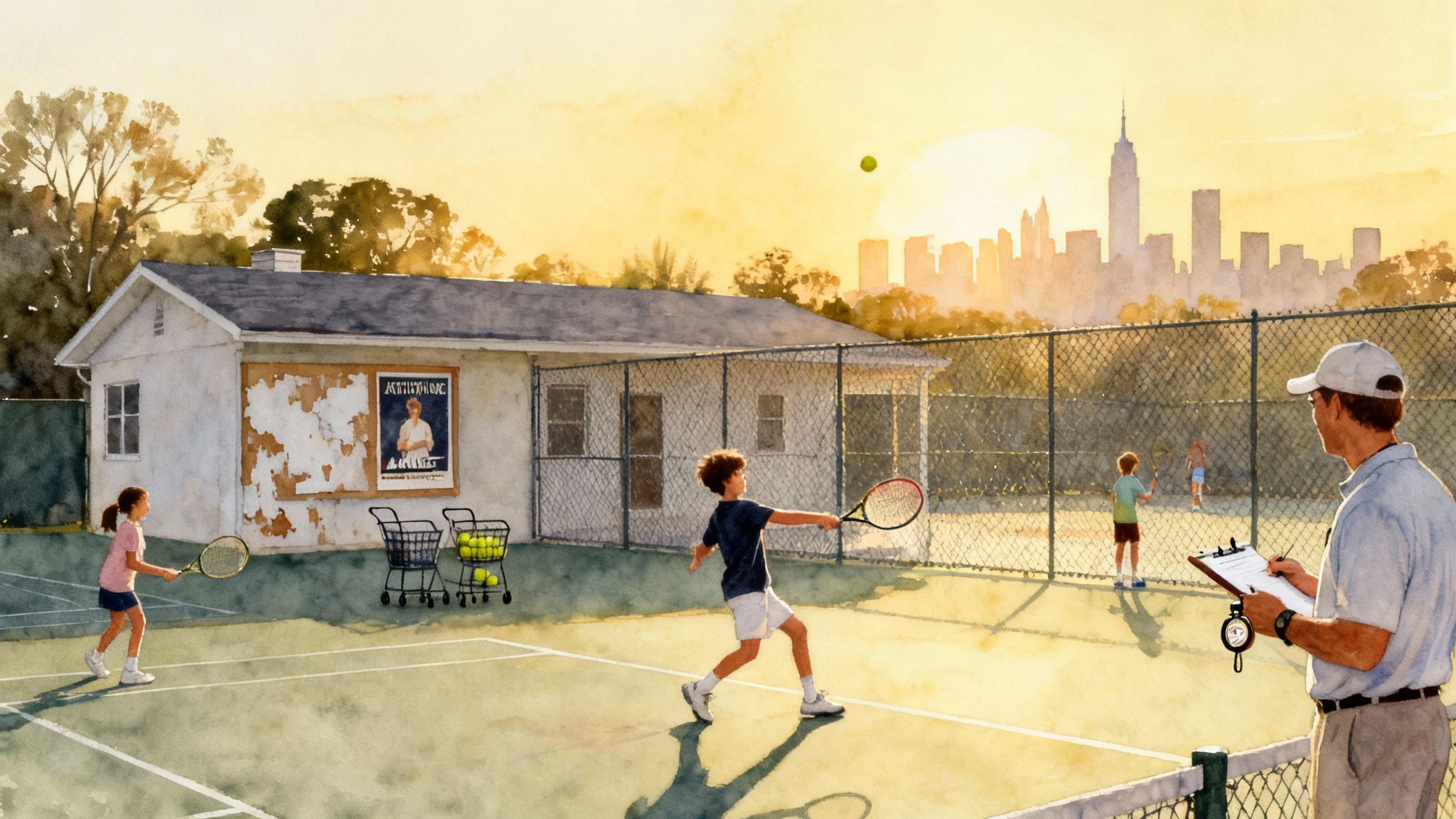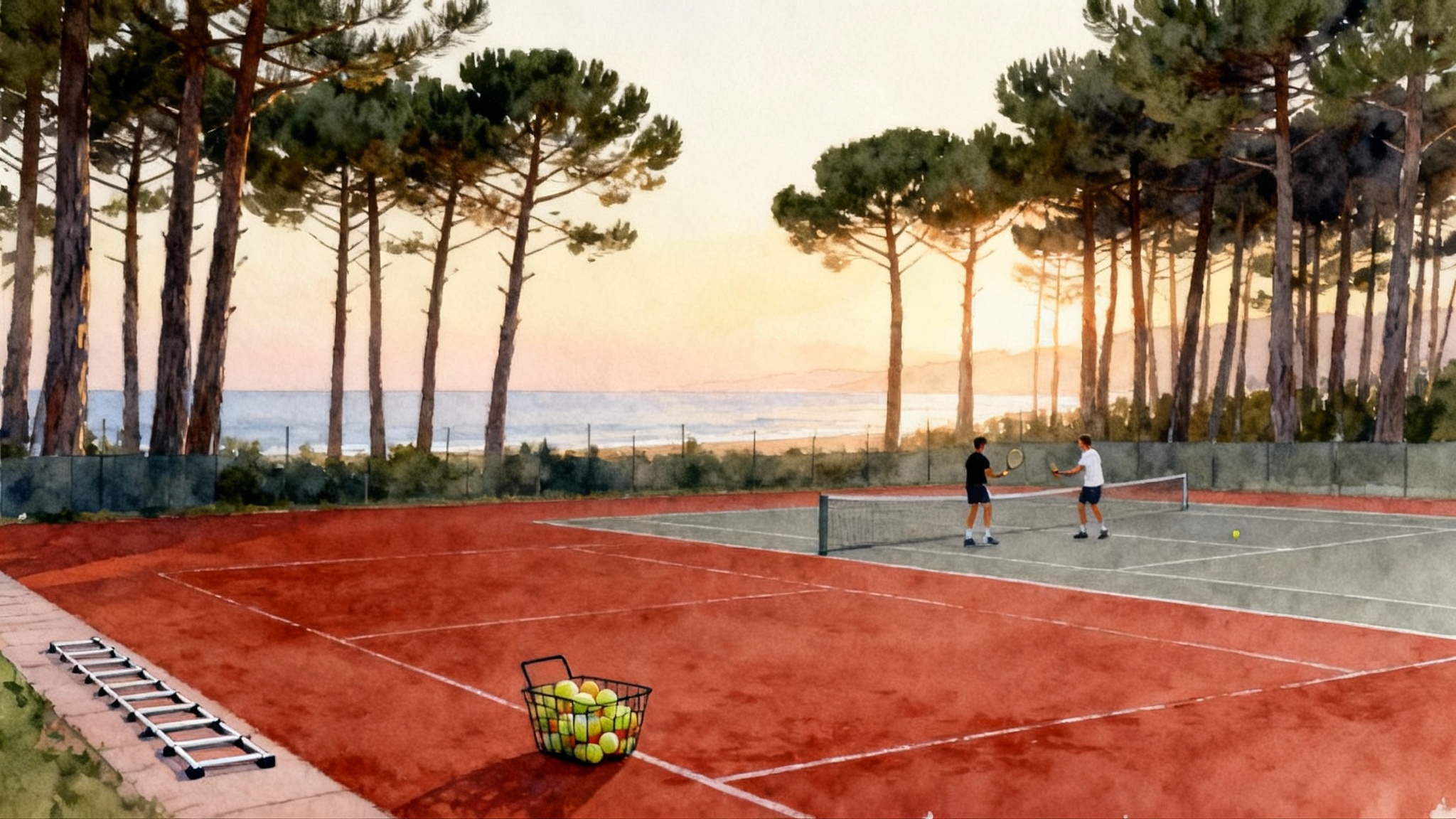From El Palmar to Villena: How JC Ferrero Equelite Forged Alcaraz
Carlos Alcaraz did not appear overnight. This is the concrete path from his family club in El Palmar to daily work at JC Ferrero Equelite in Villena, the training choices behind his early pro rise, and the patterns families can copy.
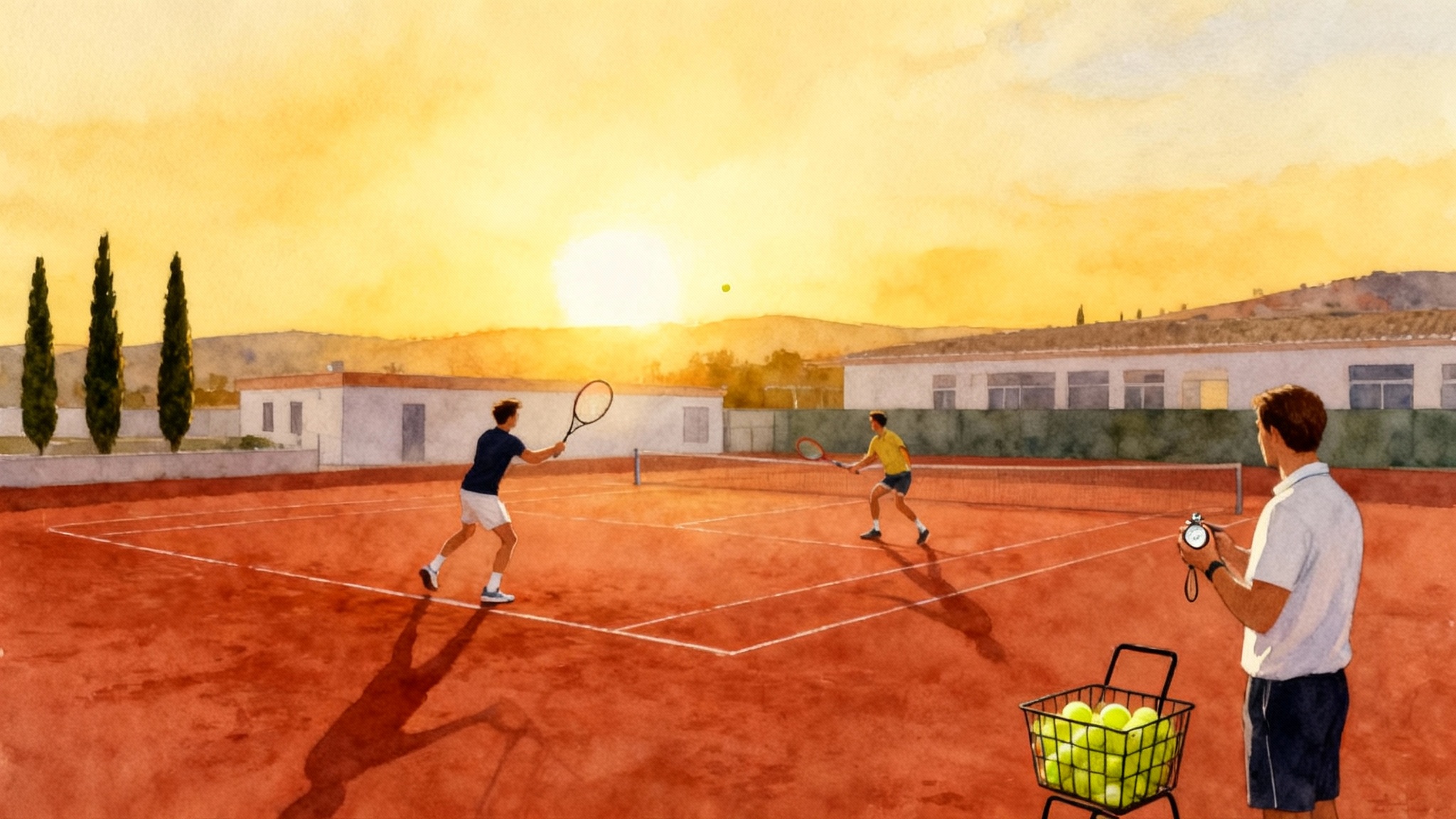
The road that started at a family club and led to Villena
Before Carlos Alcaraz lifted Grand Slam trophies, he was a kid in El Palmar hitting balls until the sun fell behind the Murcia hills. His early tennis life was grounded in a local community of coaches and hitting partners who knew him well. What changed his trajectory was a move that preserved that familiarity while widening the stage: settling into a professional training home at JC Ferrero Equelite in Villena.
Villena is just a few hours from Murcia by car, which mattered. The decision to stay based in Spain kept travel simple, language the same, and family close. Continuity was the point. Alcaraz found an academy that did not replace his tennis identity. It refined it. Under the leadership of former world number one Juan Carlos Ferrero, the academy plugged a gifted teenager into a grown-up performance system without breaking the parts that already worked. In Spain’s academy ecosystem, this balance echoes what Nadal Academy built Casper Ruud achieved in Manacor, tailored here to Alcaraz’s explosiveness.
A home base built around a mentor
Players notice when the person in charge still loves the work. Ferrero does. He is visible on court. He hits. He demonstrates. He asks for small changes with clear reasons. That mentor relationship is the backbone of Alcaraz’s pathway. The support team at Equelite then wraps around that core: assistant coaches to run blocks of repetition, fitness and physiotherapy staff to plan loads, and analysts who translate match video into next-week drills. The result is a single plan rather than a collection of opinions.
Two principles guide the day-to-day:
- Make an all-court player by training all parts every week.
- Raise the floor before the ceiling. Build reliable patterns first, then add higher-risk layers only when the base holds.
How Equelite trains a modern all-court game
Think of Alcaraz’s tennis as a toolkit with compartments. Equelite labels those compartments and trains each with repetition and game-like pressure. The academy’s daily work can be described in four pillars. The emphasis on sequencing mirrors elements outlined in the Piatti Academy to World No. 1 playbook, adapted to Alcaraz’s heavier forehand and net instincts.
1) All-court repetition that sticks
Repetition is not only about volume. It is about context. Equelite builds scenarios that mirror real points so the brain ties a stroke to a decision. Here are representative drills used to build Alcaraz’s variety:
- Directional ladders: two crosscourt balls with margin, then the third ball down the line, followed by an automatic transition to the net. This bakes in depth discipline, a change of direction on the right ball, and a first volley to finish.
- Drop-shot decision tree: start a rally from neutral, then feed a short middle ball. The player must choose drop, angle, or heavy drive based on the opponent’s position called out by the coach. The goal is not the drop itself but reading the court in time.
- Serve plus one patterns: buckets of first serves into the deuce wide and ad T, each followed by a pre-called first forehand to a target. The pattern changes only after a streak of ten solid executions, which trains reliability under monotony.
- Return blocks: stand two steps farther back than match position, take a full cut at three returns, then step in closer for three compact blocks. Switching distances on purpose builds an adjustable return instead of a fixed one.
The theme is simple. Each micro-drill ends with forward movement. You finish points at the net often enough in training and it shows up when the score matters.
2) Point-construction under a stopwatch
Equelite treats point-building as a skill on its own. The staff uses short timed games to force the player to think in sequences:
- Three-ball plays to 11: server must win the point in three shots or less to count. This builds clarity about how a point ends before it starts. Receive side plays to extend past three balls, rewarding patience.
- Pattern vs pattern: forehand inside-out plus inside-in versus backhand crosscourt plus on-the-rise redirect. Coaches call out the pattern and time each point. Players must execute the plan at tempo, not just in theory.
- Neutral to green-light: start with a low-risk rally to deep middle, and the first ball that lands short enough becomes a green-light attack. The goal is to switch from rally to offense with one decision, not two or three hesitant steps.
These games design the mental map you saw in New York in 2022 and Paris in 2024. Alcaraz knows the road from a neutral ball to a winning strike because he has driven it a thousand times with a clock ticking.
3) Fitness periodization with a growth mindset and a calendar
Equelite’s conditioning looks like a school timetable. There are seasons and sub-seasons. Loads go up and down on purpose, and each surface shift has its own emphasis:
- Clay blocks: capacity over pure speed. Longer live-ball rallies, lateral sliding mechanics, eccentric leg work, and core endurance. Think of this like adding a bigger fuel tank.
- Grass blocks: acceleration first. Short-burst sprints, footwork triangles, low volley entries, and ankle stability. This is your turbo button.
- Hard court phases: blend of both with an extra focus on shoulder care and landing mechanics after jumps and open-stance strikes.
Alcaraz’s staff treats the body like a project plan. A typical month shows three progressive load weeks and one deload week where intensity dips and quality sleep becomes the training goal. Gym work is not random. It matches the stroke work. If the week is heavy on serve plus one pace, the overhead press load stays modest and rotator cuff work increases. If the week leans on transition play, posterior chain and deceleration sessions get priority. The idea is to arrive at tournaments fresh but prepared.
4) Controlled exposure to pro-level sparring
Top juniors often get tossed into adult practice sets without guardrails. Equelite does the opposite. They manage the first exposures to pro speed and weight of shot with rules that compress or expand the court:
- Half-court offense: play offense only into half the opponent’s court while the pro hits full court. This forces accuracy under pressure while preventing blowouts.
- Ball-count caps: up to five-ball rallies before the point must end. It teaches juniors to play with intent instead of survival.
- Scored patterns: start each point from a coach-fed ball into the junior’s weaker wing. The goal is not to survive but to practice a specific escape pattern.
These controls build confidence. When the guardrails come off, the player has already succeeded at pieces of the pro game.
Tournament stair-steps instead of leaps
Parents often ask when to play bigger events. Equelite’s answer with Alcaraz was a staircase, not an elevator. The team chose a Challenger-heavy diet in 2020 and 2021, with limited wild cards and a focus on earning wins week after week. The staircase worked for three reasons:
- Volume of pressure moments: Challengers deliver tiebreaks, closing games, and early-round scrambles in constant doses. You get more chances to learn how to handle scoreboarding stress than in a handful of top-tier wild cards.
- Budget of travel and recovery: staying largely in Europe and especially in Spain reduced jet lag and costs. That meant more weeks playing and fewer weeks recovering from airports.
- Clear weekly reviews: after each event the team logged three categories only. One pattern to keep, one to drop, and one to test next week. That focus kept improvements moving in a straight line.
By the time the main-tour invitations arrived, Alcaraz already had the habit of winning matches in bunches. He knew how to manage a five-day tournament rhythm because he had lived it.
Incremental goals that tie to training
Goal setting at Equelite is not a motivational poster. It is a contract between drills and outcomes. A typical sequence looked like this:
- Training target: raise first-serve percentage by five points over three weeks without losing average speed.
- Practice measure: 200 serves per session with radar and zone goals, twice a week.
- Match metric: two of three matches that week must cross the first-serve goal.
- Tournament application: choose events where serve patterns will be tested, like faster hard courts or altitude Challengers.
The team repeated this on the return game, forehand spin window, and transition success rate. Each micro-goal earned a small celebration and a new plan. There was no single stunt or magic change. Just rhythm.
The breakthrough years explained by the process
When Alcaraz won his first major in New York in 2022, many focused on his shotmaking. The deeper story was endurance in choices. Long matches did not produce panic. He kept building points the same way in the fifth set as in the first. That habit came from Equelite’s stopwatch games and fitness blocks.
Two seasons later, he lifted the Coupe des Mousquetaires in Paris in 2024. The run had rough patches. He absorbed them and kept imposing variety. A drop shot here, a backhand line there, a sprint to the net when the ball begged for it. The result is recorded on the ATP Tour player profile, yet the method is the interesting part. He did not add a new superpower for Paris. He arrived with reliable tools and the confidence to use them under stress.
What families and coaches can copy today
You do not need a Grand Slam budget to apply the patterns that shaped Alcaraz. Here are concrete steps that scale.
1) Choose an academy that integrates coaching and fitness
- What to look for: a clear calendar that shows when the player lifts, when they do footwork, and how those choices relate to the strokes trained that day. Ask for a sample week.
- Why it matters: a player who sprints hard on Monday and fires serve plus one on Tuesday will arrive flat on Wednesday unless the loads are planned. Integration gives you freshness for quality reps.
- How to act: during a trial week, watch who talks to whom. If the coach, fitness lead, and physio update each other daily, you have found structure. Programs like Emilio Sánchez Academy Barcelona make this link explicit.
2) Anchor the project around a mentor who stays
- What to look for: a lead coach who shows up at least three training sessions a week and takes ownership of the player’s plan.
- Why it matters: teenagers need consistent feedback in the same voice. Frequent coach turnover sets development back because the player must decode new language each month.
- How to act: ask the academy how they cover travel weeks and who writes the post-match reports. The name should not change every few events.
3) Build a tournament staircase
- What to look for: a schedule that clusters events by level and geography. For example, three back-to-back national events, then a training week, then two higher-level tournaments.
- Why it matters: success breeds success. A staircase lets the player collect wins and lessons in quick succession.
- How to act: define the next eight weeks on paper with a simple rule. You only step up a level after two deep runs at the current level.
4) Train on multiple surfaces to build weapons, not just comfort
- What to look for: weekly exposure to a second surface if your home courts are all the same. If you train on hard courts, add a clay session each week in season.
- Why it matters: surface changes reveal technical gaps you miss at home. The slice that works on hard courts must be cleaner on grass. The heavy forehand that dominates on clay must aim straighter on faster courts.
- How to act: schedule surface-themed blocks. Two weeks focused on sliding and defense, then two weeks on first-strike patterns and low contact points. Match the gym plan to that theme.
5) Use controlled sparring with better players
- What to look for: structured sets against older or higher-ranked hitters with rules that keep points competitive.
- Why it matters: unstructured beatdowns teach helplessness. Smart constraints teach solutions.
- How to act: ask the academy to run half-court offense, ball-count caps, or serve-start games when your player faces pros. Keep score to measure progress.
6) Tie every goal to a measure and a drill
- What to look for: a one-page sheet with three current goals and the drills that feed each goal.
- Why it matters: improvement without measurement is luck. Measurement turns luck into a repeatable method.
- How to act: after each tournament, fill out three lines. Keep, drop, test. Build the next week’s plan from those lines.
Why staying in Spain mattered, and why it might matter for you
Staying based in Spain did more than cut travel time. It allowed Alcaraz to return to the same bed after tough weeks and start the next block without delay. The language of coaching stayed the same. Family could watch training days, not only big matches. Your version might be different. The principle is to maximize development time and minimize friction. If a strong academy exists within reach that aligns with your values and provides integrated support, the benefits of stability often outweigh the imagined upside of a long-distance relocation.
The through line from local club to major champion
Look at Alcaraz’s story not as a fairy tale but as a map. A supportive local start in El Palmar built love for the game and early fundamentals. The move to a professional home in Villena added structure without stripping identity. All-court repetition gave him options. Point-construction games taught him when to use them. Fitness periodization created durability. Controlled sparring brought the future into the present. A Challenger staircase tested and rewarded those gains. Incremental goals stitched it together. The trophies in New York and Paris were not the beginning of something new. They were proof that the method holds under the heaviest lights.
Closing thoughts
Families do not need to copy the names on the gate to copy the plan. Find a place that integrates tennis and fitness, insist on a mentor who endures, climb the tournament ladder in measured steps, and run training blocks that build weapons on more than one surface. Do this and the path from your local courts to bigger stages becomes less mysterious. It becomes a set of choices you can make on purpose, one solid week at a time.
